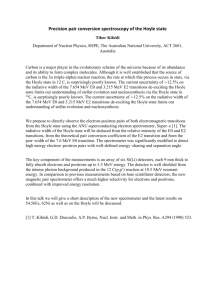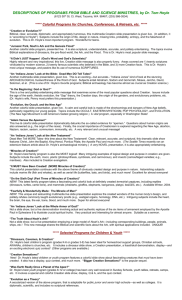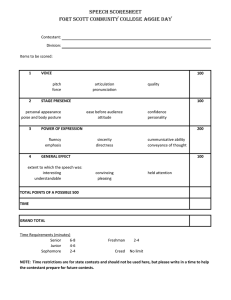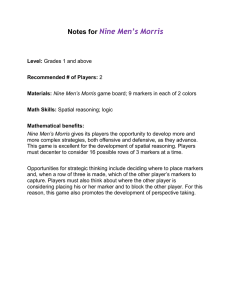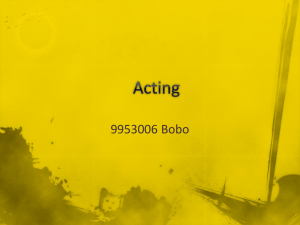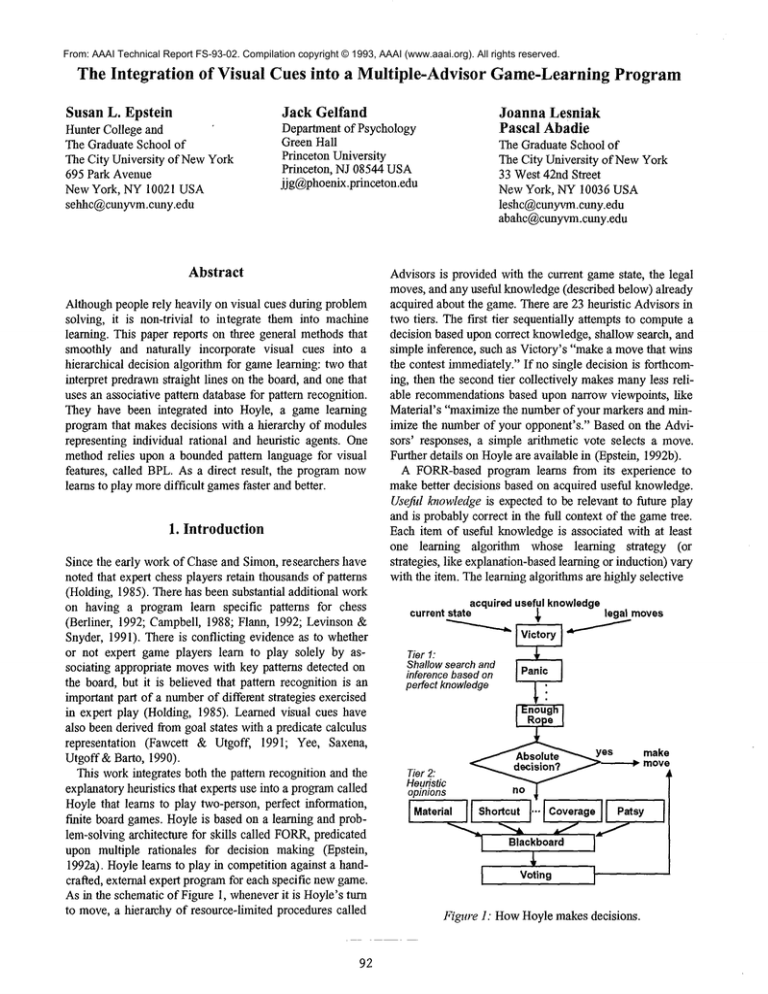
From: AAAI Technical Report FS-93-02. Compilation copyright © 1993, AAAI (www.aaai.org). All rights reserved.
The Integration
of Visual Cues into a Multiple-Advisor
Susan L. Epstein
Jack Gelfand
Hunter College and
The Graduate School of
The City University of NewYork
695 Park Avenue
New York, NY 10021 USA
sehhc@cunyvm.cuny.edu
Department of Psychology
Green Hall
Princeton University
Princeton, NJ 08544 USA
jjg@phoenix.princeton.edu
Abstract
Althoughpeople rely heavily on visual cues during problem
solving, it is non-trivial to integrate them into machine
learning. This paper reports on three general methodsthat
smoothly and natnrally incorporate visual cues into a
hierarchical decision algorithm for gamelearning: two that
interpret predrawnstraight lines on the board, and one that
uses an associative pattern database for pattern recognition.
They have been integrated into Hoyle, a game learning
program that makes decisions with a hierarchy of modules
representing individual rational and heuristic agents. One
methodrelies upon a botmdedpattern language for visual
features, called BPL.As a direct result, the programnow
learns to play moredifficult gamesfaster and better.
1. Introduction
Since the early work of Chase and Simon, researchers have
noted that expert chess players retain thousandsof patterns
(Holding, 1985). There has been substantial additional work
on having a program learn specific patterns for chess
(Berliner, 1992; Campbell, 1988; Flann, 1992; Levinson
Snyder, 1991). There is conflicting evidence as to whether
or not expert game players learn to play solely by associating appropriate moveswith key patterns detected on
the board, but it is believed that pattern recognition is an
important part of a numberof different strategies exercised
in expert play (Holding, 1985). Learned visual cues have
also been derived from goal states with a predicate calculus
representation (Fawcett & Utgoff, 1991; Yee, Saxena,
Utgoff &Barto, 1990).
This workintegrates both the pattern recognition and the
explanatory heuristics that experts use into a programcalled
Hoylethat learns to play two-person, perfect information,
finite board games. Hoyle is based on a learning and problem-solving architecture for skills called FORR,predicated
upon multiple rationales for decision making (Epstein,
1992a). Hoyle learns to play in competition against a handcrafted, external expert programfor each specific newgame.
As in the schematicof Figure 1, wheneverit is Hoyle’s turn
to move,a hierarchy of resource-lflnited procedures called
92
Game-Learning Program
Joanna Lesniak
Pascal Abadie
The Graduate School of
The City University of NewYork
33 West 42nd Street
New York, NY 10036 USA
leshc@cuny-~n,cuny.edu
abahc@cunyvm.cuny.edu
Advisors is provided with the current gamestate, the legal
moves, and any usefifl knowledge(described below) already
acquired about the game. There are 23 heuristic Advisors in
two tiers. The first tier sequentially attempts to computea
decision based upon correct knowledge, shallow search, and
simple inference, such as Victory’s "makea movethat wins
the contest immediately." If no single decision is forthcoming, then the second tier collectively makesmanyless reliable recommendationsbased upon narrow viewpoints, like
Material’s "maximizethe numberof your markers and minimize the number of your opponent’s." Based on the Advisors’ responses, a simple arithmetic vote selects a move.
Further details on Hoyleare available in (Epstein, 1992b).
A FORR-basedprogram learns from its experience to
make better decisions based on acquired useful knowledge.
Useful knowledgeis expected to be relevant to future play
and is probably correct in the full context of the gametree.
Each item of useful knowledgeis associated with at least
one learning algorithm whose learning strategy (or
strategies, like explanation-basedlearning or induction) vary
with the item. The learning algorithms are highly selective
acquiredusefulknowledge
currentstate
legal moves
~
Tier1:
inferencebasedon
perfect knowledge
~peI
~r
Heuristic
opinions
no ~
Blackboard
l
I
J,
_.
I
Votingt
Figure 1: HowHoyle makes decisions.
Advisor
Tier Relevant Information
Useful Knowledge
Learning Strategy
Victory
1
Next moveis a win
Significant states
Deduction
Panic
1
Null moveheuristic detects a loss
Significant states
Deduction
Leery
2
Questionable move
Play failure and proof failure
Abduction
Pitchfork
2
Applicable fork
Fork knowledge base
Explanation-based learning
Open
2
Reliable opening
Opening knowledge base
Induction
Patsy
2
Pattern associated with win or loss
Pattern knowledgebase
Associativepattern classifier
Table 1: Examplesof Hoyle’s Advisors. Theseprocedures are general rationales that reference one or moreitems of useful
knowledge,each supported by its o~nalearning strategy.
about what they retain, maygeneralize, and maychoose to
discard previously acquired knowledge.Individual Advisors
apply current useful knowledge to construct their
recommendations. Examples of Hoyle’s Advisors, along
with their useful knowledgeand its associated learning
strategy, appear in Table1.
There is an important distinction drawn in this paper
betweenthinking and seeing in gameplaying. By "thinking"
we meanthe manipulation of symbolic data, such as "oftenused opening gambit;" by "seeing" we meaninference-free,
explanation-free reaction to visual stimuli. This acquired
"sight" is compiledexpert knowledge.Hoyle "sees" through
visual cues integrated into its decision-makingprocess with
three new Advisors in the second tier. Consistent with
Hoyle’slimited rationality, these Advisorsreact to lines and
clusters of markers without any hmnaninterpretation of
their significance and without reasoning. The three are a
step toward the construction of a system that both uses and
learns visual cues. They provide powerful performance
gains and promise a natural integration with learning. The
first two new Advisors rely on predrawnlines on the game
board; other notices patterns of markers. Although the
descriptions of these Advisors are presented in the context
of a single family of games,Section 5 extends the results to
Hoyle’s entire domain.
2. Using Predrawn Lines
Morris games have been played for centuries throughout the
world on boards similar to those in Figure 2. Weuse them
as examples here because their substantial search spaces
(ranging from 9 million to 776 billion states) provide
interesting challenges. For clarity, we distinguish carefully
here between a game(a board, markers, and a set of rules)
and a contest (one complete experience at a game, from an
initially emptyboard to somestate wherethe rules terminate
play). Werefer to the predrawnstraight lines visible in
Figure 2 simply as lines. Anylocation where a marker may
legitimately rest is called a legal position or simply a
position. (In morris games, the intersection of two or more
lines is a position) A position without a markeron it is said
to be empty. Althoughthe programdraws pictures like those
in Figure 2 for output, the internal, computational
representation of any gameboard is a linear list of position
values (e.g., black or white or blank) along with the identity
of the mover and whether the contest is in the placing or
sliding stage. The programalso makesobvious representational transformations to and from a two-dimensionalarray
to normalize computations for symmetry, but the array has
no meaningful role in moveselection. The gamedefinition
includes a list of predrawnlines and the positions on them.
A morris gamehas two contestants, black and white, each
with an equal ntwnberof markers. A morris contest has two
stages: aplacingstage, whereinitially the board is empty,
(19)
(a)
(c)
Figure 2: Somemorris boards with (a) 16 positions for five or six men’smorris, and 24 positions for (b) nine men’smorris
and for (c) 11 men’smorris. The darkenedline segmentsrepresent the metric unit discussed in Section
93
2
3
)
()
2
3
10
(4
15
16
Figure 3: A five men’s morris state with white to movein
the placing or the sliding stage.
Figure 4: A five men’s morris state with white to movein
the sliding stage.
and the contestants alternate placing one of their markerson
any empty position, and a sliding stage, where a turn
consists of sliding one’s marker along any line drawnon the
game board to an immediately adjacent empty position. A
marker maynot jump over another marker or be lifted from
the board during a slide. Three markersof the samecolor on
immediatelyadjacent positions on a line form a mill. Each
time a contestant constructs a mill, she captures (removes)
one of the other contestant’s markers that is not in a mill.
Onlyif the other contestant’s markersare all in mills, does
she capture one from a mill. (There are local variations that
permit capture only during the sliding stage, permit hopping
rather than sliding whena contestant is reducedto three near
a contest’s end, and so on.) The first contestant reduced to
two markers, or unable to move,loses.
the markeron 3 in Figure 3, for example,is { 1, 2, 2- 3, 10,
16}. A set of markers belonging to a single contestant P
producesa cover, a multiset denoted
Cp = {el ¯ Vl, c2" v2,..., Cn"Vn}
that lists the positions v 1, v2 ..... vn that P’s markersaffect
and the numberof times q which each vi is so affected. Cp
is the union of the coverages of the positions where P has
markers.In Figure 3, for example,the white cover is
¯ 1,2,3,2.4,5,2.6,2CW={2
7,2.8,9, 11, 13, 14}.
The cover difference C ~ D of
C={cl ¯ Vl, c2" v2,..., Cn" Vn}
and
D={dl ¯ Wl, d2" w2 ..... dm" Wm}
is definedto be the multiset
C ~ D = {x. y [ y = vi for somei = 1, 2 ..... n; x. y ~ C;
y~wjfor anyj = 1, 2 ..... m}.
Cover difference is not commutative. In Figure 3, for
example, CB ~ CW= {10, 12, 15, 2- 16} while CW~ CB=
O.
The Coverage algorithm attempts to spread its markers
over as manypositions as possible, particularly positions
already coveredby the other contestant, and tries to do so on
positions that are multiply covered(i.e., ci > 1) by the other
contestant. Assume,without loss of generality, that it is
white’s turn to move. In the placing stage, Coveragerecommendsa move to every empty position ci ¯ v i
CB~ CWwhere ci >1. If there are no such positions, it
recommends a move to every position in CB~ CWwhere
ci = 1. If there are no such positions of either kind, it recommends a moveto every empty position where ci > 1. For
example, in Figure 3 with White to move in the placing
stage, CB ~ CW= {10, 12, 15, 2 ¯ 16} so Coverage
recommendsa move to 16.
In the sliding stage, Coverage recommendseach legal
movethat increases [ vi I, the numberof the mover’sdistinct
covered positions. Let (p,q) denote a sliding movefrom
position p to position q. In Figure 4 the legal moves(1,7),
(9,6), (9,13), (10,3), (10,16), (14,7) change[ vi [
0,0, 0, -1, respectively, so Coveragerecommends
(9,6).
the sliding stage, however,one’s cover can also decrease.
Therefore, Coveragealso recommends
each legal slide to a
2.1 The Coverage Algorithm Intuitively,
a marker
offensively offers the potential to groupothers along lines it
lies on (juxtaposition) and to facilitate movementthere
(mobilio,), while it defensively obstructs the opposition’s
ability to do the same.Intuitively:
¯ the coverage of a marker represents the positions over
whichit has potential influence to cluster and move
¯ the cover of a contestant represents the combinedinfluence
of her markers
¯ the cover difference between two contestants represents
those positions over whichthe first has potential influence
and the seconddoes not.
More formally, when a marker is placed on any position
on a line, it is said to affect all the positionson that line, including its own.The coverage of a position is the multiset
of all distinct positions that it affects. Amultiset is a set in
which each element may appear more than once. An
element that appears more than once is preceded by a count
of the numberof its occurrences. Thus {a, 2 ¯ b} denotes a
set of one a and 2 b’s. A multiset can represent repeated as
well as singular influence, a helpful way to describe the
relative potential of positions.
A marker positioned where two lines meet induces two
copies of its position in its coverage.Thusthe coverageof
94
1
2
4
3
6
7
19
(
14
22
Figure 5: Anotherfive men’smorris state with white to
movein the sliding stage.
23
24
Figure6." A placing state in nine men’smorris, white to
move.
position ci ¯ vi ~ CBwhere ci >1 but for which ci <1 in CW
In Figure 5, for example, where the legal movesare (2,3),
(6,9), (8,4), (8,7), (10,3), (10,9), (14,7), and
CB={2¯ 1,2.2,2.3,2-4,2-5,6,7,8,10,3.11,312, 2. 13, 2.14, 2. 15, 2.16}
CW={2̄ 1,2.2,2.3,2.4,2.5,2.6,2.7,2.8,2-9,
2. 10, 11, 13, 2.14, 15, 2. 16}
those positions are 11, 12, 13, 15, so Coverage can only
recommend(14,15).
however, Hoyle’s decisions improved markedly. (Shortcut
was not part of this experiment.) Data averages results
across five rims. WithCoverage,Hoyleplayed better faster;
after 32.75 contests it had learned well enoughto draw10 in
a row. The contests averaged 33 moves, so that the program
was exposed during learning to at most 1070.5 different
states, about .012% of the search space. From that
experience, the programwas judged to simulate expert play
while explicitly retaining data on only about .006%of the
states in the gamegraph.
2.2 The Shortcut algorithm The Shortcut algorithm
In post-learning testing, Hoyleprovedto be a reliable, if
addresses long-range ability to move,and does so without
imperfect, expert at five men’s morris. Whenthe program
forward search into the game graph. Wetake the standard
played 20 additional contests against the model with
definitions from graph theory for adjacency, path, and path
learning turned off, it lost 2.25 of them. Thus Hoyle after
length. The algorithm for Shortcut begins by calculating the
learning is 88.75%reliable at five men’s morris, still a
non-zero path lengths betweenpairs of same-color markers,
strong performance after such limited experience and with
including that from a marker to itself. For example, in
such limited retention in so large a search space. Additional
Figure 6 the shortest paths betweenthe white markers on 2
testing displayed Increasing prowess against decreasingly
skilled opposition, an argument that expertise is indeed
and 20 are [2, 5, 6, 14, 21, 20], [2, 3, 15, 14, 21, 20], and [2,
5, 4, 11, 19, 20]. Next, the algorithmselects those pairs for
being simulated.
which the shortest non-zero length path between them is a
There are approximately 20 million states in akidada
minimum.
It then retains only those shortest paths that meet
(referred to here as "six men’s morris"). Althoughit has
the following criteria: every empty position lies on some substantially larger search space than five men’s morris,
line without a markerof the opposite color, and at least one
akidada is played on the same board. Given the crowding
position on the path lies at the intersection of twosuch lines.
that results, the gameis actually somewhateasier to learn.
All three paths identified for Figure 6 are retained because
With Coverage and Shortcut Hoyle learns to play expertof positions 5, 14, and 5, respectively. Shortcut recommends level akidadain 14 contests on average.
a placing or sliding moveto the middlemostpoint(s) of each
Witha search space about 16,000 times larger than that of
such path. In Figure 6, Shortcut therefore recommends five men’s, nine men’s morris is a more strenuous test of
movesto the midpoints 6 and 14, 15 and 14, and 4 and 11.
Hoyle’s ability to learn to play well. Because there is no
This algorithm,styled as spreadingactivation, is very fast.
definition of expert outcomefor this game,we chose simply
to let the programplay 50 contests against the model.
2.3 Results with Coverage and Shortcut Whenpredrawn
WithoutCoverageand Shortcut, Hoyle lost every contest.
board lines are taken as visual cues for juxtaposition and
With them both, however, there was a dramatic
mobility, Hoylelearns to play challenging gamesfaster and
improvement.Inspection showedthat the program played as
better. Prior to Coverage, Hoyle never played five men’s
well as a humanexpert in the placing stage of the last 10
morris very well. There are approximately9 million possible
contests. During those 50 contests, which averaged 60
board positions in five men’s morris with an average branch
moveseach, it lost 24 times, drew 17 times, and won nine
factor of about 6. After 500 learning contests Hoylewas still
times. (Some minor corrections to the model are now
losing roughly 85%of the time. Once Coveragewas added,
underway.)The first of those wins was on the 27th contest,
95
9?#
###
###
?##
#?#
###
#?#
#?#
###
?#?
###
###
?##
###
##?
#?#
###
#?#
9?9
###
###
?##
#?#
##?
#?#
#?#
#?#
Figure7. A templateset used by the original version of the pattern classifier for a 3 x 3 grid.
and four of them were in the last six contests, suggesting
that Hoylewas leatvzing to play better. Withthe addition of
less than 200 lines of game-independentcode for the two
new visually-cued Advisors, Hoyle was able to learn to
outperform expert system code that was more than 11 times
its length and restricted to a single game.The morris family
includes versions for 6, 9, 11, and 12 men, with different
predrawnlines. At this writing, Hoyle is learning themall
rapidly.
It should be noted that neither Coveragenor Shortcut applies useful knowledge; instead, they direct the learning
program’s experience to the parts of the gamegraph where
the key information lies, highly-selective knowledgethat
distinguishes an expert from a novice (Epstein, 1993; Ericsson & Smith, 1991). If this knowledgeis concisely located,
as it appears to be in the morris games,and the learner can
harness it, as Hoyle’s learning algorithms do, the program
learns to play quickly and well. As detailed here, this general improvementcomesat a mere fraction of the developmenttime for a traditional game-specificexpert system.
3. Learning Patterns
Oneof the authors is an expert game-player.Initially he was
asked to learn one new game every week. so that we might
develop, for each new game, a perfect player algorithm to
serve as Hoyle’s opposition during learning. The games we
gave him were progressively moredifficult. It is a habit ha
our laboratory to sketch the gameboard on a piece of paper
and then use coins to represent the markers. One week,
when he arrived to report his progress, the game "board"
was so well used that the coins had worntranslucent paths
on the paper. A protocol follows.
I played this gamefor a very long time. At first I
playedit with a friend, but then, after a fewhours, lie
tired of it, so I playedit by myself.I playedit a long,
long time, for manyhours. After a while I began to
notice that patterns appeared. [Whenqueried, he
described these as small clusters of same-colored
markers forming a V-like or L-like shape.] After an
even longer time, I began to notice that, once these
patterns appeared, something happened. I wouldwin,
maybe,or lose. Maybenot right away, but after a few
moves. Then I figured out why those patterns made
this happen,and here is the algorithin.
It was not the (correc0 algorithm we were nowinterested
in, but this remarkable description of learning. An
accomplished game player was confronted with a task in
96
which he could not bring his usual expertise to bear. As he
persisted, some mental process collected visual cues for
him, a process he had not consciously initiated. But once
that process had results, and he noticed them, he could use
those visual cues to play well and even to calculate why
those visual cues werecorrect. If it workedfor our expert, it
could work for a machine.
Of course, gamelearning with pattern recognition is not
new. De Groot proposed, and Chase and Simon refined, a
recognition-association modelto explain chess skill (Chase
& Simon, 1973; de Groot, 1965). Despite a thoughtful
refutation of their recognition-associationtheory, the idea of
patterns as chunks in experts’ memories has persisted
(Holding, 1985). MACH
integrated chunks identified
humanmaster chess players from grandmaster games, into
the evaluation function of Phoenix (George &Schaeffer,
1991). With this addition, Phoenix made better movesbut
no longer played in real time. Levinson modified chimksto
include empty squares and threat-defense
relations
(Levinson, et al., 1991). His chess-learning program,
Morph,learns and stores about 5000patterns that it uses to
play chess.
The novelty of the approach described in this section is
that it integrates a real-time, low-levelpattern learner into a
high-level reasoning framework.Our premise is that visual
patterns are not a primary reasoning device (an argument
Holding supports with substantial empirical evidence) but
that they are an important fallback device, just as they were
in the protocol.
Hoyle,as a limitedly rational program,deliberately avoids
exhaustive search and complete storage of its experience.
Therefore whenHoylelearns patterns, it retains only a small
numberof those encountered during play, ones with strong
empirical evidence of their significance. The programuses a
heuristically-organized, fixed-size database to associate
small geometrical arrangements of markers on the board
with wipningand losing. The associative pattern database is
a new item of useful knowledge.
The pattern database is constructed from templates by the
pattern classifiet, an associated learning algorithm. A
template is a partial description of the location of markers
on the board. A "?" in a template represents an X, an O, or
an empty space; "#" is the don’t care symbol. A sample
template set for a 3 x 3 grid is shownin Figure 7. The
middlemosttemplate, for example, could be instantiated as
"X’s on the endpoints of some diagonal." The templates in
Figure 7 were chosen from experience; more general
methodsfor their construction appear in the next section.
At the end of each contest, the pattern classifier matches
every state against a set of templates, adjusting for all the
symmetries of the two-dimensional plane. A pattern is an
instantiation of a template, e.g., X’s in the comers of a
diagonal. The pattern database consists of those patterns
whichhave appeared at least twice during play. Moststates
match one or more templates several ways and therefore
make multiple contributions to the pattern database. Each
pattern also records pattern so’engths: the number of
contests in whichit participated in a win, a loss, and a draw.
It is importantto forget ill the pattern database, primarily
to discount novice-like play during the early learning of a
game. There will be winning contests, and patterns
associated with them, that were due to the learner’s early
errors. Wehave therefore implementedtwo ways to forget
in the pattern database. First, whenthe database is full and a
new entry should be made, the least recently used entry is
eliminated. Second,at the end of every contest, the pattern
strengths are multiplied by 0.9. Thusa pattern is a generalization over a class of states: those that have recently
occurred with some frequency and contain sflnple
configurations of markers. The pattern classifier formscategories (winning, drawingor losing) based on observed game
states and associates responses to the observed states by
leaming during play.
Patsy is an Advisor that ranks legal next movesbased on
their fit with the pattern database. Patsy looks at the set of
possible next states resulting from the current legal moves.
Each next state is comparedwith the pattern level of the
database. A matchedwinning pattern awards the state a +2,
a matched drawing pattern a +1, and a matched losing
pattern a -2. A state’s score is the total of its pattern values
divided by the nmnber of patterns in the cache. Patsy
recommends
the movewhose next state has the highest such
score. Ties were broken by randomselection.
To show Patsy’s contribution to game learning, the
Advisor was tested first with a severely pared-downversion
of Hoylethat had only two of the original Advisors, Victory
and Panic, plus Patsy. The pattem store was limited to 30.
50
i
!
!
i
i
!
i
i
!
46
40
~ 35
Victory
+
Pa~-i
o 25
o 10
5
0c
I
l
5
10
I
I
I
I
I
15 20 25 30 35
Numberof Contests
I
40
I
45 "5
Figure 8. The performance of a pared-downversion of
Hoyle, with and without Patsy.
97
Three 50-contest tournaments between a perfect tic-tac-toe
player and this programwere run to assess its performance.
The perfect player was a look-up table of correct moves.
The average cumulative number of wins and draws for the
learning programis plotted against contest numberin Figure
8. The graph compares the pared-down version’s average
performance, with and without Patsy, against the perfect
contestant’s. Clearly the pared-down version performed
consistently better with Patsy.
This experiment showed that a pattern recognition
component could be a smoothly integrated, contributing
element of a game playing system. A simple game was
chosento facilitate debuggingthe pattern classifier and measuring performanceagainst an absolute standard. Morethan
two Advisors would have obscured the contribution of the
pattern-associative component.
Patsy was then tested, again with the templates of Figure
7, in the full version of Hoyle on nine different games
defined on a 3 x 3 grid (e.g., lose tic-tac-toe, les pendus,
marelle). Onceagain the pattern database was limited to 30.
There was no degradation of prior performance, i.e., the
games that Hoyle had been able to learn to play expertly
without Patsy it could also learn to play just as quickly and
well with Patsy. In addition, statistics indicated that Hoyle
frequently judged Patsy amongthe most significant of its
Advisors for learning such a game, i.e., an Advisor whose
recommendationsagreed with expert play more often than
those of most Advisors. The extension of Patsy to more
difficult games, where it is expected to makean important
contribution, appears in the next section.
4. Identifying Board-SpecificTemplates
Although Patsy does eventually contribute to good move
choices, its original templates were for a specific game
board (a 3 x 3 grid) and predetermined by people. Our new
version of Patsy has a template generator that is applied to
deduce templates from the topology of the board.
Hoyle now calculates the templates for Patsy when it
encounters a new game. These templates are detected as
instantiations of a feature languagewith a visual bias called
BPL(Bounded Pattern Language). Let the version of the
gameboard drawnfor output, as in Figure 2, be called the
picture. The program constructs a met~qc graph whose
nodes are the legal positions for markers, e.g., in morris
gamesthe intersection points of predrawnlines. There is an
edge betweena pair of nodes in the metric graph if and only
if it is sometimeslegal to movea marker in one turn from
one of the corresponding positions to the other, e.g., in
morris games the metric graph’s edges correspond to
predrawn line segments. Each edge is labeled with the
Euclidean distance between its two positions that is
measurable from the picture. The metric graph for five
men’smorris appears in Figure 9, with letters to identify the
nodes. NowHoyle computes the metric unit for the game
board, the smallest label in the metric graph. (Each game
Figure 9: The metric graph for five men’s morris.
board in Figure 2 has a single bold line that represents an
instance of its metric unit.) Next the program finds
instantiations of the BPLexpressions. A BPLexpression is a
class of shapes with ?’s in its required positions and #’s in
its irrelevant ("don’t care") ones.
There are five valid expressions in BPL:straight lines,
squares, diagonals, L’s and triangles (the equivalent of the
V’s in the protocol). Each is defined below; exampleslist
the vertices in Figure 9 that are identified with ?’s to form
the appropriate shape. BPL takes a single hem of view
parameter that determines the area over which a template
mayextend. Field of view has been set to 4 in the following
definitions. The valid BPLexpressions are
¯ A BPLstraight line is a predrawnstraight line segmentin
the picture whoseendpoints are no more than 4 metric units
apart. A BPLstraight line mayinclude more than two positions. The endpoints, and no other points, are markedby a ?.
¯ A BPLsquare, with any orientation, is a square whose
vertices are positions and whoseedges are predrawnstraight
line segments in the picture. A BPLsquare labels its 4
vertices, and no other points, with ?’s. Everypair of vertices
of a BPLsquare are no morethan 4 metric units apart.
¯ Given a square whose vertices are positions and whose
edges may or may not be predrawn in the picture, a BPL
diagonal is any contiguous segmenton a diagonal of such a
square, such that the endpoints of the segment are no more
than 4 metric units apart. A BPLdiagonal mayinclude more
than two positions. The endpoints, and no other points, are
markedby a ?.
¯ A BPLL is a pair of perpendicular line segmentsthat form
a single right angle in the picture. Thethree endpointsof the
line segments must be positions, and every pair of such
positions must be no morethan 4 metric units apart. The two
"legs" of a BPLL may be different lengths. A BPLL may
include morethan three positions. The three endpointsof the
line se~nents, and no other points, are markedby a ?.
¯ A BPLtriangle is a triangle whosevertices are positions,
all three of whoseedges are predrawnin the picture, and
along whichevery pair of positions is no morethan 4 metric
units apart. The sides of a BPLtriangle maybe different
lengths. The three vertices of a BPLtriangle, and no other
points, are markedby a ?.
98
A board-specific template is an instantiation of a BPL
expression. The concern is, of come, that there not be too
many board-specific templates, nor too few. Too many
templates could overwhelma learner, particularly one with a
small pattern cache. Too few templates could overlook
important patterns. Patsy must have enoughtime to test for
patterns with all its templates in the few seconds of
computingtime allotted to it. The parameterized field of
view is a heuristic that must balance powerwith efficiency.
For nowwe set field of view to 4, becauseit seemsto strike
that balance.
For the five men’s morris board with field of view 4,
Hoyle generates only 13 templates whenit applies BPLto
the board in Figure 9: straight lines AB, AC, DE, BE, and
DF; the square DFNL;the diagonal DN; and the L’s BED,
EDH, ABE, BAG,EDL, and FDL. (Recall that templates
are unique up to the symmetries of the two-dimensional
plane, so that, for example, DNand FL are considered the
same template.) Wehave prototyped the instantiation of
BPLfor several gameboards and found that the number of
templates continues to be quite reasonable. (For nine men’s
morris,it is 18.)
It is important to understandthat board-specific templates
are calculated only once, when Hoyle first encounters the
game board. Once the templates are identified, then the
patterns that are instantiations of themare learned at the
same time as any other useful knowledge. A pattern is an
instantiation of a templatein one of four ways:all blank.%all
markers of the first contestant, all markers of the second
contestant, or all occupied by a specific configuration of
markers. The response associated with a pattern’s presence
is tabulated as a win for the first contestant, a winfor the
secondcontestant, or a draw.
The new version of Patsy uses the board-specific
templates muchthe way the old version used the templates
in Figure 7, but with several important modifications:
¯ Ties are represented by recommendingevery move to a
highest-scoring state.
¯ Only two states per contest are used to generate the
patterns, the state in which each contestant madeits last
non-forced move.
¯ Onlypatterns whosepredictions are perfectly reliable are
retained. If a pattern enters the pattern database and its
responsechanges,it is discarded. This insistence on flawless
correlation expects that contestants eventually play very
well, else Hoylewill repeatedly discard a pattern that should
be learned but appears in a"misplayed"contest.
¯ Pattern matching is hierarchical, i.e., if a pattern is
matchedto the current state, no attempt is made to match
any of its subpatterns. For example, in Figure 9, DFNL
is a
BPLsquare. If an instantiation of DFNL
were found with all
white markers, then the white L’s of the form FDLwouldbe
ignored, since they are subpatterns of the square. Hierarchical pattern matchingwas essential to Hoyle’sability to learn
the game; recommendationsbased on subpattems as well as
patterns overemphasizedthe importance of a single large
pattern, and adversely affected decision making.
draw
draw
draw
draw
black wins
draw
draw
draw
draw
draw
white wins
black wins
Figure 10: Hoyle’s leamedpatterns for five men’smorris, with their responses.
The newversion of Patsy is a moresophisticated Advisor,
and replaces the old one. At this writing, the newversion of
Patsy has been tested for five men’s morris. Hoyle computed the 13 templates and applied them to leam 12 pattems, shownwith their responses in Figure 10. The pairing
of states in the first and secondlines of Figure10 is deliberate. Exceptfor the rightmost pair, each pattern in the second
row maybe derived from the pattern directly aboveit by interchangingthe colors of the markersand the result. The advantagethat black seemsto derive in the last pair maybe related to the fact that black movesfirst in this game.
Patsy is no less fallible than any other second tier
Advisor. Althoughthe patterns of Figure 10 have arisen in
every run, they are not perfect. One can, for example,
construct a gamestate including a "winning" pattern from
whichthe "winner’ must inevitably lose the contest.
Wehave run preliminary tests on the full version of Hoyle
with and without Patsy. The program played five men’s
morris against the external expert programuntil Hoylecould
draw 10 consecutive contests. Then we turned leaming off
and tested the programagainst the expert programand three
other programs of gradually decreasing ability. (See
(Epstein, 1993) for a full description of this process.) Hoyle
with Patsy learned to play well slightly faster, and
performed more reliably after gaining than Hoyle without
Patsy. Further testing is required to demonstrate the
statistical significance.
5. Discussion
All three new second-tier Advisors arose in the context of
the class called morris games, which includes versions for
up to 12 men on boards of various designs, like those in
Figure 2. To confirm that the new Advisors are game-independent., we have tested Coverageand Shortcut on all the
99
gamesHoyle had previously learned, we have tested the earlier version of Patsy on those to which the Figure 7 templates are applicable, and we have tested the newversion of
Patsy on three gamesplayed on different boards. The three
new Advisors in no way diminish the program’s ability to
learn and play the broad variety of gamesat which it had
previously excelled (Epstein, 1992b). In manyof the games
all three were applicable and even gave excellent advice, although there was no dramatic improvementin learning time.
(Recall that Hoyle already was able to learn these games
quite efficiently, usually in less than 100contests.) Heuristic
Advisors are needed most in the middlegame, however,
wherethe large numberof possible movesprecludes search.
It has been our experience with more complex games,
where one would have many Advisors, that openings are
typically memorized, and that the endgamecan be wellplayed with Advisors that reason about knownlosing and
winning positions. Inspection reveals that Shortcut and
Coverage contribute to decisions only in the middlegame,
while Patsy works on the opening and middlegame. All
three new Advisors prove to filter the middlegame
alternatives to a few likely moves, ones that might then
benefit from limited search.
Current work includes extensions to other games. Weare
now in the expert development cycle for other membersof
the morris family: trique, nerenchi, murabaraba, and 11
men’s morris. Webuild an expert model, Hoyle learns to
defeat it, weobserve and correct the model’sflaws, and then
we challenge Hoyle with the new version.
Unlike Morph’spatterns, Hoyle’s are purely visual, without an underlyingrationale (Levinson, et al., 1991). Weplan
next to test a variety of off-the-shelf learningstrategies (e.g.,
decision trees, neural nets) to learn pattern strengths for use
with the new version of Patsy. Fnture work also includes
fining the field of view value automatically, and augmenting
BPLso that it includes boundedregions in its language.
E. was partially supported by NSFGrant 9001936.
I
References
(a)
(b)
Figure 11: A pair of gameboards for nine men’s morris.
6. Conclusions
Hoyle is an ongoing exploration of how general domain
expertise, like knowledgeabout howto play games, can be
applied to developexpertise rapidly in a specific subdomain,
like a particular game.The programis progressing through a
sequence of games ordered by human-estimated degree of
difficulty. At watersheds where knowledgemust be added to
continue Hoyle’sprogress throughthe list, it is importantto
assess what was missing, and whyit was relevant. Until the
morris games, there was little need for vision, except for
economyafforded by symmetry.
Predrawn lines on a game board are important, readily
accessible regularities that support better playing decisions.
Peoplefind it far simpler, for example,to learn to play on a
board with lines, like the one in Figure 1 l(a), than on
board that only has small dots to marklegal positions, like
the one in Figure 1 l(b). The lines, we believe, serve
heuristics to formulateplans and guide search.
Historical pattern data is demonstrablyhelpful in distinguishing good middlegamepositions from mediocre ones.
The workon Patsy differs from other’s workin that it does
not address the strategic rationale behindthe patterns, only
their presence(Levinson,et al., 1991)~
The brevity of the coderequired to capitalize on these visual cues for a variety of problemsargues for the limitedly
rational perspective of the FORR
architecture. FORR
facilitates the transparent introduction of new, goodreasons for
makingdecisions. Testing a newAdvisor is a simple task.
Finally, the improvementShortcut, Coverage, and Patsy
have on skill development argues for the significance of
visual representations as an integral part of decision making.
Each of them demonstrably improves Hoyle’s ability to
learn to play well.
Acknowledgments
This presentation was improved by conversations with Ron
Kinchla and Stan Matwin, and by commentsfrom several
anonymous
referees. J. G. was partially supported by a grant
from the James S. McDonnell Foundation to the Human
Information Processing Groupat Princeton University. S. L.
100
Berliner, H. (1992). Pattern Recognition Interacting with
Search (CMU-CS-92-211).Carnegie Mellon University.
Campbell, M. S. (1988). Chunking as an Abstraction
Mechanism,Ph.D. thesis. Carnegie Mellon.
Chase, W. G. & Simon, H. A. (1973). The Mind’s Eye
Chess. In W. G. Chase (Ed.), Visual Information
Processing (pp. 215-281). NewYork: AcademicPress.
de Groot, A. (1965). Thought and Choice in Chess. The
Hague: Mouton.
Epstein, S. L. (1992a). Capitalizing on Conflict: The FORR
Architecture.
In Proceedings of the Workshop on
Computational Architectures for Supporting Machine
Learning and KnowledgeAcquisition, Ninth International
MachineLearning Conference Aberdeen, Scotland.
Epstein, S. L. (1992b). Prior Knowledge Strengthens
Learning to Control Search in WeakTheory Domains.
International Journal of Intelligent Systems, 7, 547-586.
Epstein, S. L. (1993). Toward a Theory of Well-Guided
Search. In Proceedings of the AAAI Fall Symposiumon
Games:Planning and Learning Raleigh.
Ericsson, K. A. &Smith, J. (1991). Prospects and Limits
the Empirical Study of Expertise: AnIntroduction. In K.
A. Ericsson, &J. Smith (Ed.), Towarda General Theory
of Expertise
Prospects and Limits (pp. 1-38).
Cambridge:CambridgeUniversity Press.
Fawcett, T. E. & Utgoff, P. E. (1991). A Hybrid Methodfor
Feature Generation. In Proceedings of the Eighth
International Workshopon Machine Learning (pp. 137141). Evanston: MorganKaufrnann.
Flann, N. S. (1992). Correct Abstraction in CounterPlanning: A Knowledge Compilation Approach, Ph.D.
thesis. OregonState University.
George &Schaeffer. (1991). Chimkingfor Experience.
D. F. Beal (Ed.), Advances in ComputerChess VI (pp.
133-147). London: Ellis Horwood.
Holding, D. (1985). The Psychology of Chess Skill.
Hillsdale, NJ: LawrenceErlbaum.
Levinson, R. & Snyder, R. (1991). Adaptive PatternOriented Chess. In Proceedings of the Eighth
International Machine Learning Workshop (pp. 85-89).
Morgan Kaufmann.
Yee, R~ C., Saxena, S., Utgoff, P. E. &Barto, A. G. (1990).
Explaining Temporal Differences to Create Useful
Concepts for Evaluating States. In Proceedings of the
Eighth National Conferenceon ArtTficial Intelligence (pp.
882-888). Boston, MA:AAAIPress.

